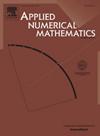安德森加速收敛分析及在平衡化学中的应用
IF 2.2
2区 数学
Q1 MATHEMATICS, APPLIED
引用次数: 0
摘要
本文从理论和数值上研究了安德森加速法。首先,我们将小深度 Anderson 方法的收敛结果扩展到一般非线性情况。更准确地说,我们证明了如果定点映射是一个具有足够小的 Lipschitz 常量的收缩,那么第一类和第二类 Anderson(1) 是局部 q 线性收敛的。然后,我们将该方法应用于化学平衡的解析,以说明其有效性。由于化学系统的高度非线性和输运现象的刚性,这个测试案例被认为是一个具有挑战性的案例。牛顿法(通常为 Newton-Raphson)已被相当多的平衡和反应输运代码所采用。但是,雅各布矩阵通常条件不佳,初始数据选择不当,会导致收敛问题,尤其是当溶质迁移产生尖锐的浓度曲线时。在此,我们建议将安德森加速法与平衡系统的一种特殊表述相结合,这种表述被称为正续分数法(通常用作预处理)。正如数值模拟所显示的那样,这种方法可以大大提高化学平衡算法分辨率的稳健性,特别是因为它与一种监测安德森加速方法深度的策略相结合,以控制条件数。本文章由计算机程序翻译,如有差异,请以英文原文为准。
Anderson acceleration. Convergence analysis and applications to equilibrium chemistry
In this paper, we study theoretically and numerically the Anderson acceleration method. First, we extend the convergence results of Anderson's method for a small depth to general nonlinear cases. More precisely, we prove that the Type-I and Type-II Anderson(1) are locally q-linearly convergent if the fixed point map is a contraction with a Lipschitz constant small enough. We then illustrate the effectiveness of the method by applying it to the resolution of chemical equilibria. This test case has been identified as a challenging one because of the high nonlinearity of the chemical system and stiffness of the transport phenomena. The Newton method (usually Newton-Raphson) has been adopted by quite all the equilibrium and reactive transport codes. But the often ill-conditioned Jacobian matrix and the choice of a bad initial data can lead to convergence problems, especially if solute transport produces sharp concentrations profiles. Here we propose to combine the Anderson acceleration method with a particular formulation of the equilibrium system called the method of positive continued fractions (usually used as preconditioning). As shown by the numerical simulations, this approach makes it possible to considerably improve the robustness of the resolution of chemical equilibria algorithms, especially since it is coupled with a strategy to monitor the depth of the Anderson acceleration method in order to control the condition number.
求助全文
通过发布文献求助,成功后即可免费获取论文全文。
去求助
来源期刊

Applied Numerical Mathematics
数学-应用数学
CiteScore
5.60
自引率
7.10%
发文量
225
审稿时长
7.2 months
期刊介绍:
The purpose of the journal is to provide a forum for the publication of high quality research and tutorial papers in computational mathematics. In addition to the traditional issues and problems in numerical analysis, the journal also publishes papers describing relevant applications in such fields as physics, fluid dynamics, engineering and other branches of applied science with a computational mathematics component. The journal strives to be flexible in the type of papers it publishes and their format. Equally desirable are:
(i) Full papers, which should be complete and relatively self-contained original contributions with an introduction that can be understood by the broad computational mathematics community. Both rigorous and heuristic styles are acceptable. Of particular interest are papers about new areas of research, in which other than strictly mathematical arguments may be important in establishing a basis for further developments.
(ii) Tutorial review papers, covering some of the important issues in Numerical Mathematics, Scientific Computing and their Applications. The journal will occasionally publish contributions which are larger than the usual format for regular papers.
(iii) Short notes, which present specific new results and techniques in a brief communication.
 求助内容:
求助内容: 应助结果提醒方式:
应助结果提醒方式:


